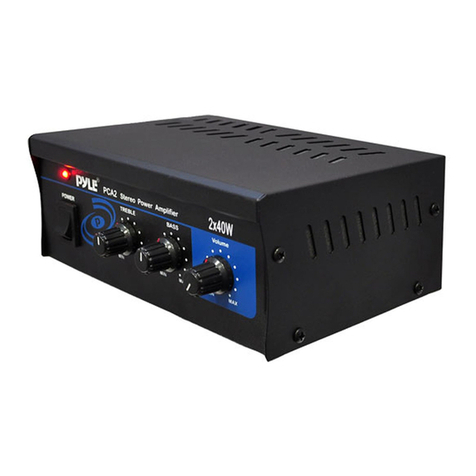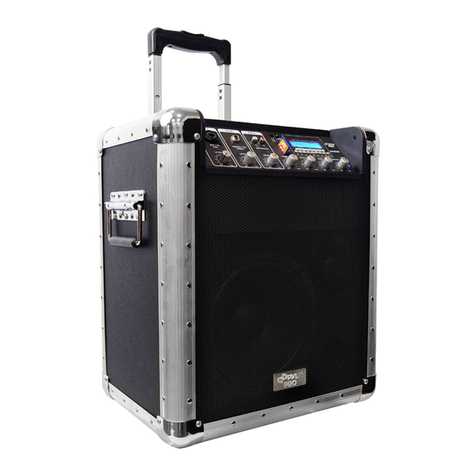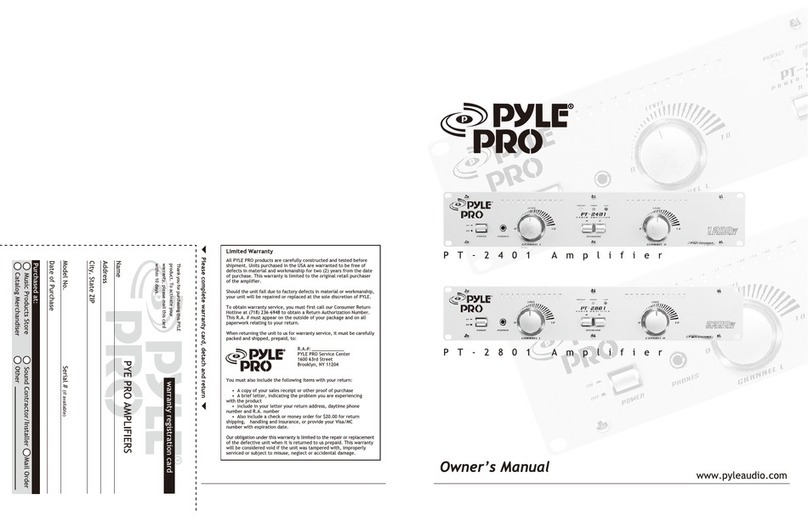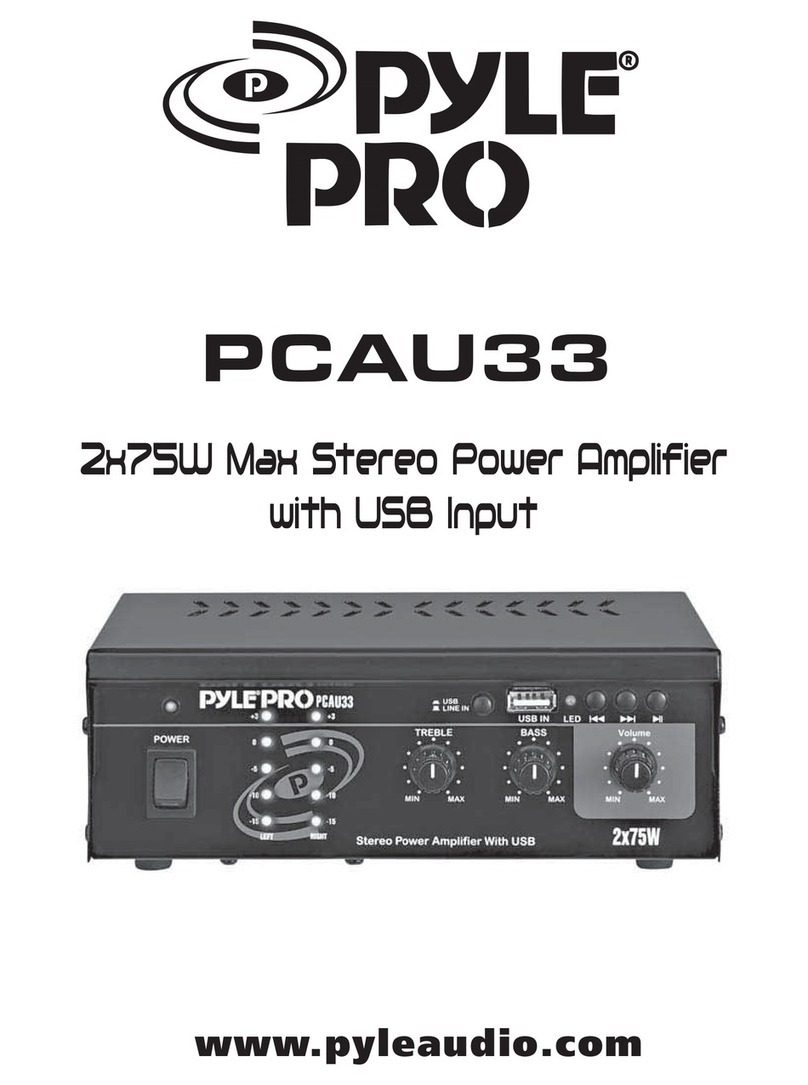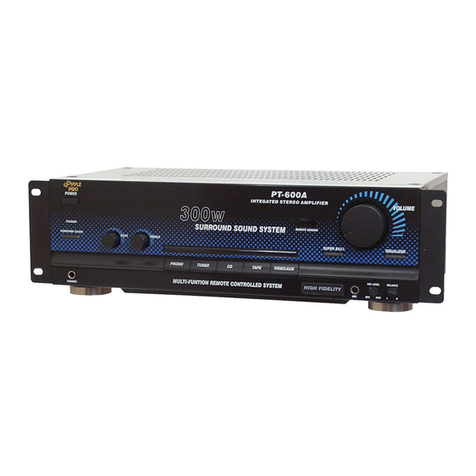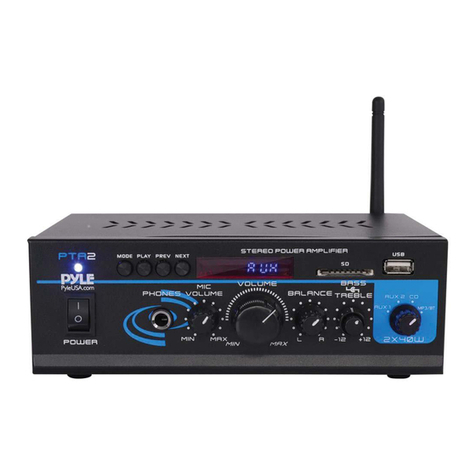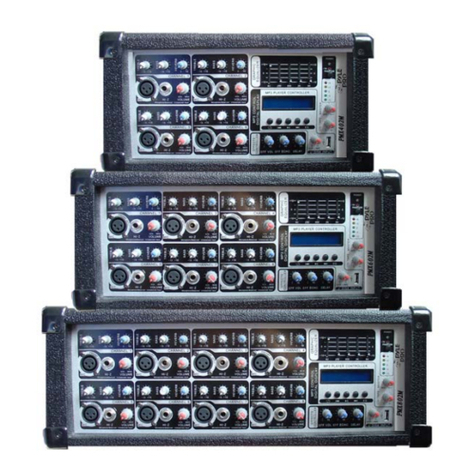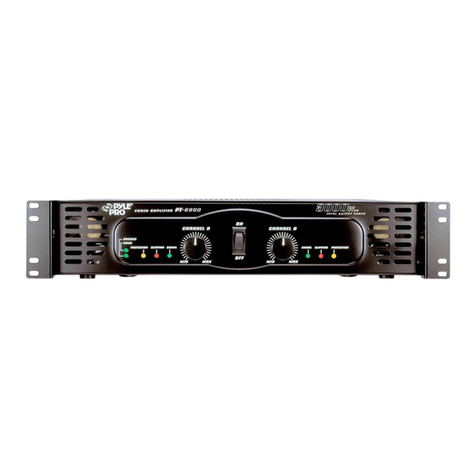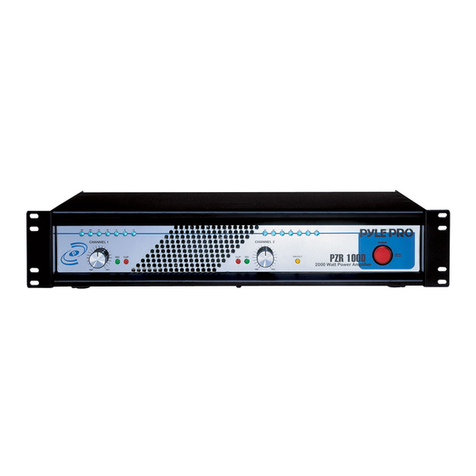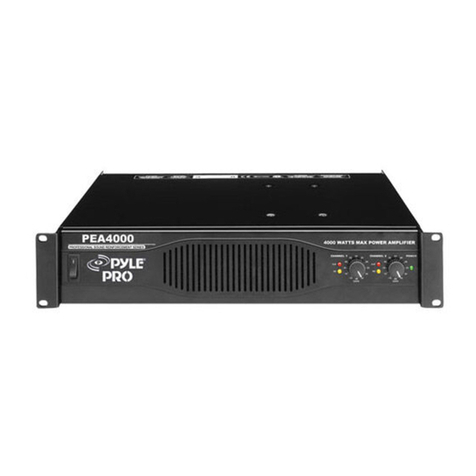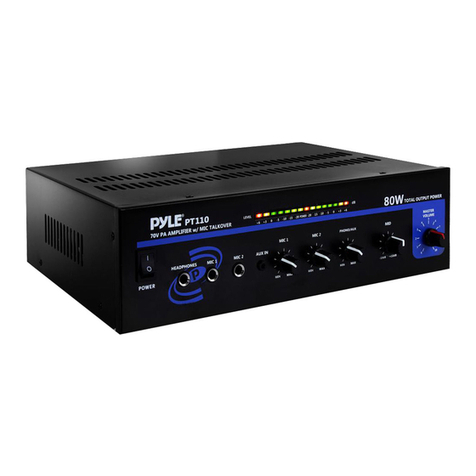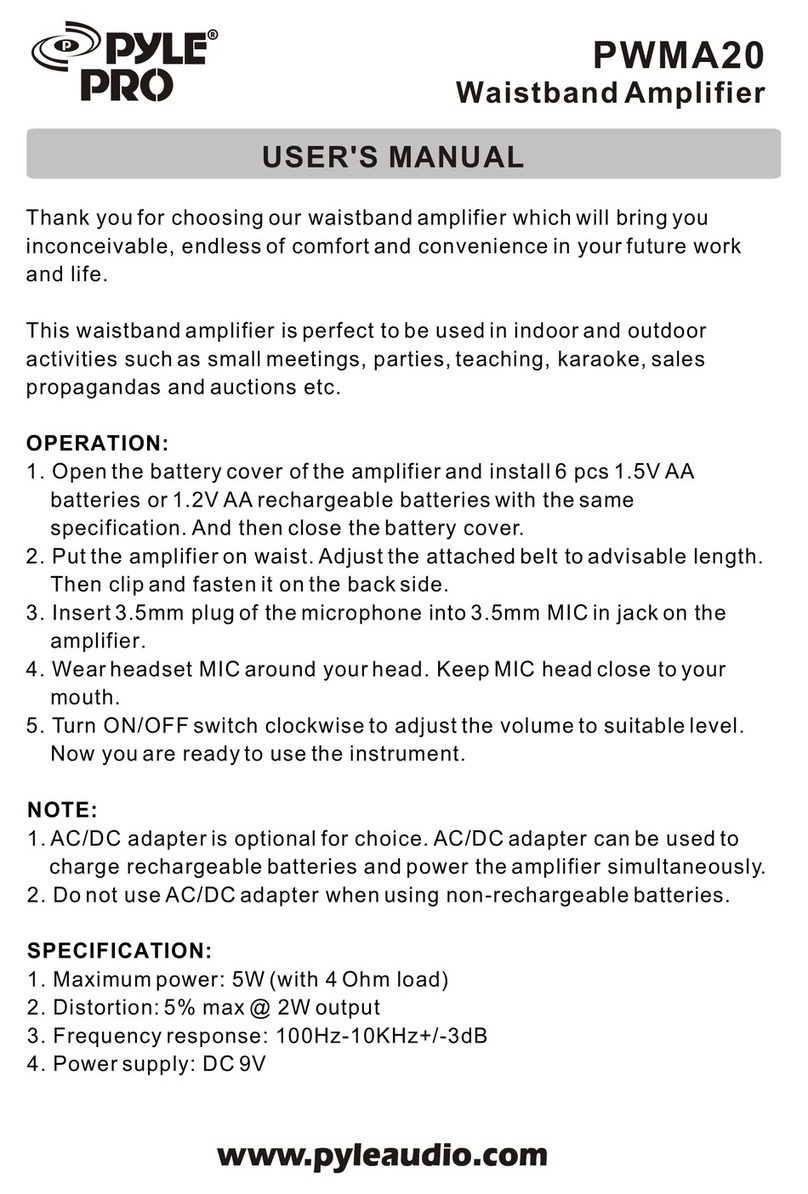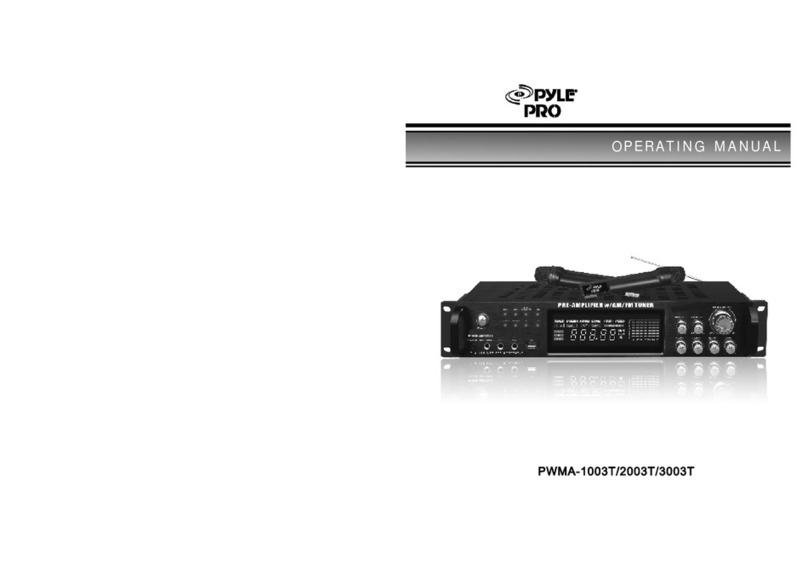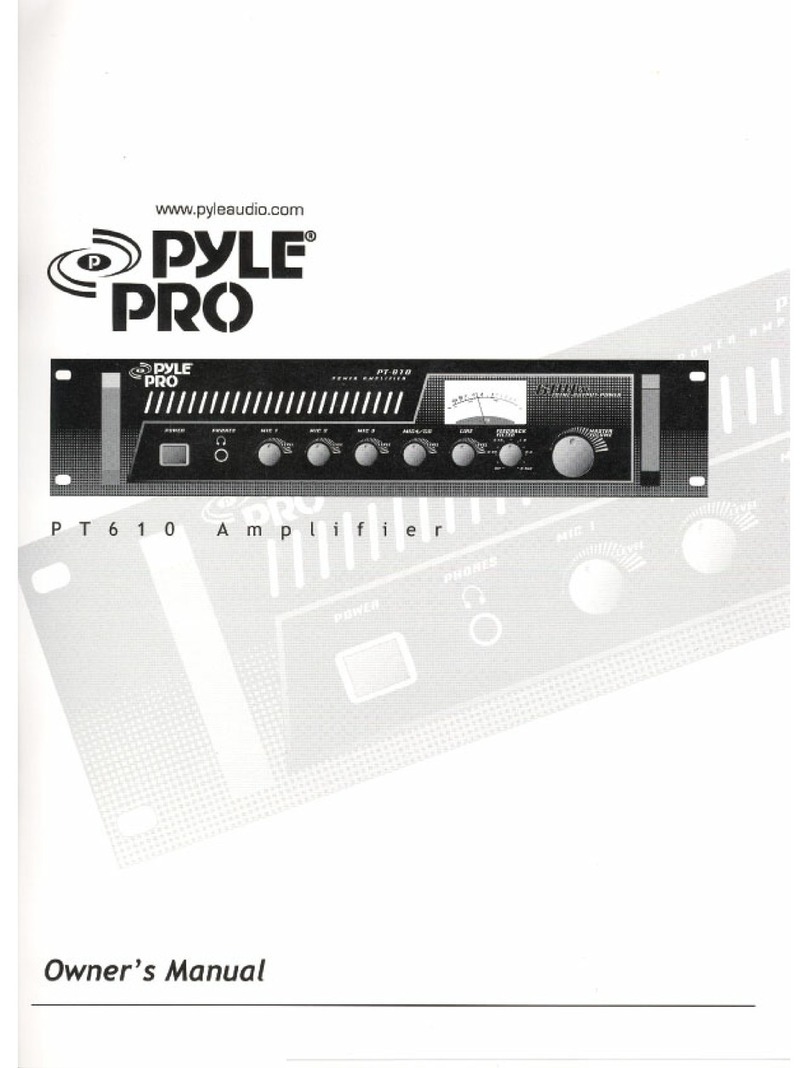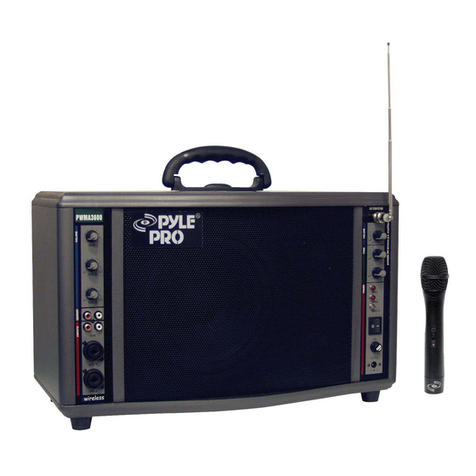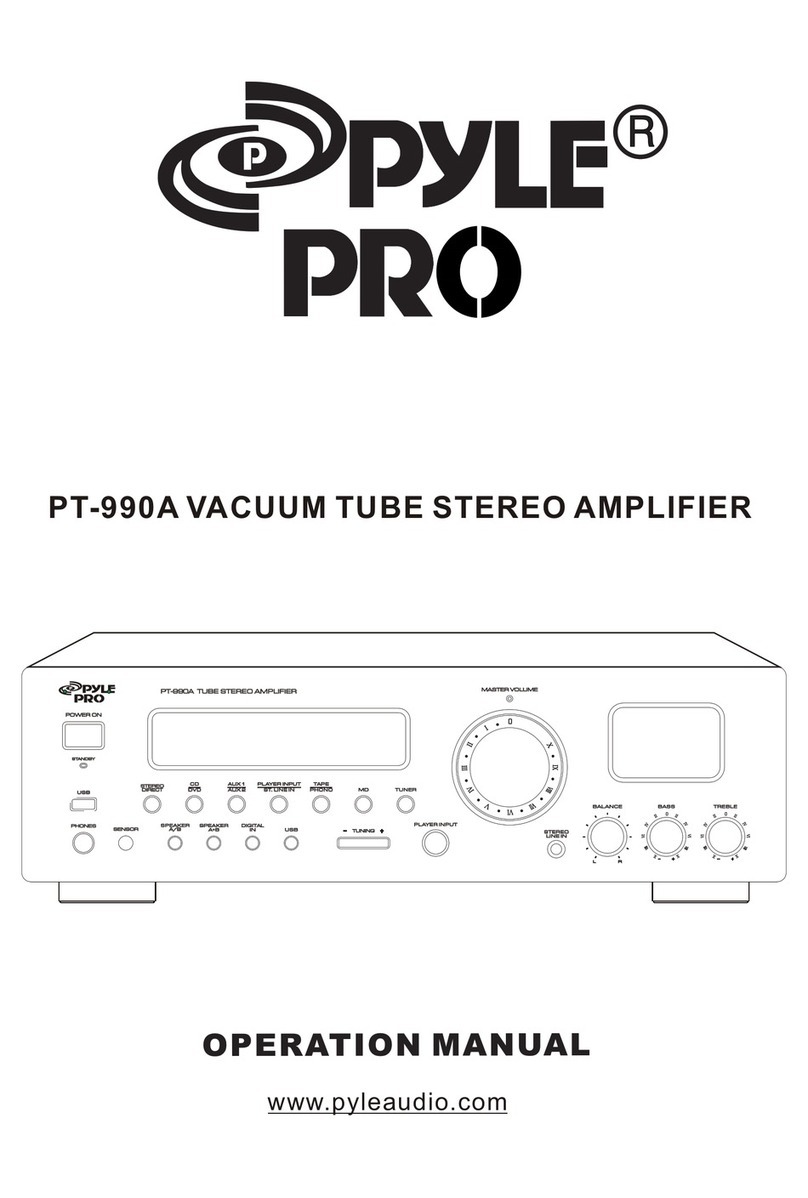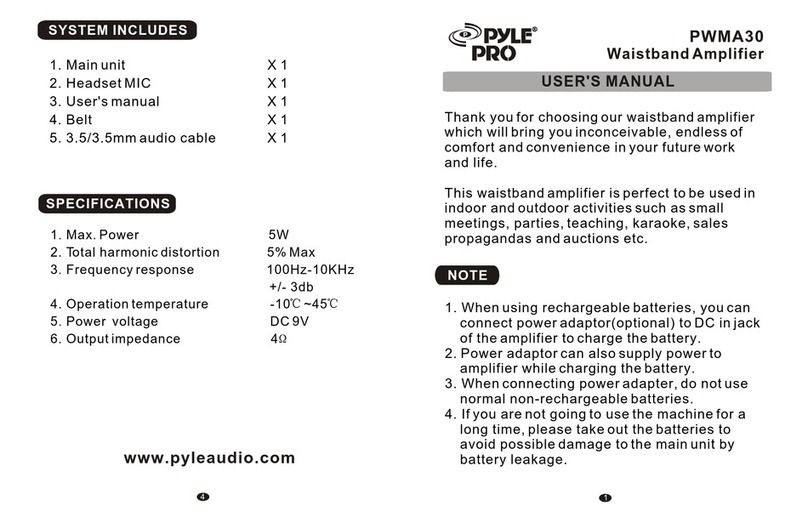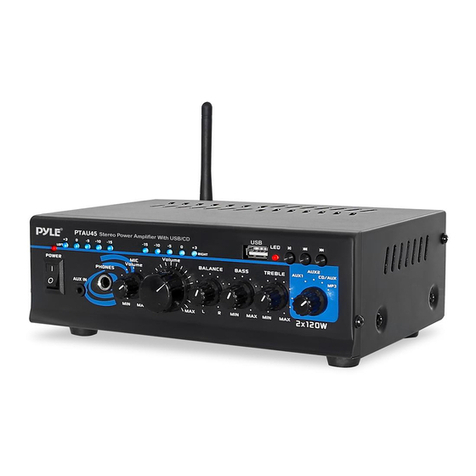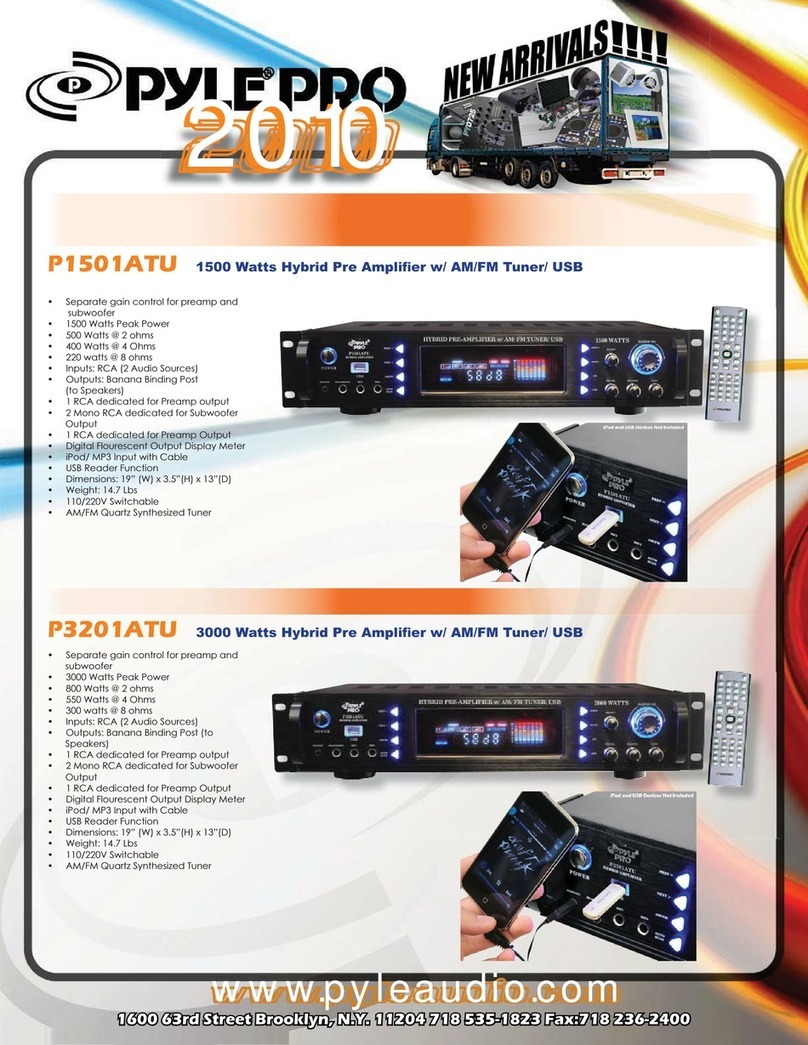
INSTALLATION GUIDELINES
Input connections
These amplifiers accept a broad range of input sources,
including Compact Disc (CD) players; DVD, Cassette, Reel-
to-Reel or other tape players; Radio Tuners; Equalizers;
Signal Processors.
Connecting a CD or DVD or tape player or tuner
In a normal installation, one would use the RCA JACKS for
connecting a CD player, DVD, tape player or tuner.
Connecting an equalizer or external signal processor
Connect the processor’s OUT to the amplifier’s INPUT
connectors.
Connecting the GND (Ground) screw terminal
Connecting a mixer or preamplifier may cause excessive
noise or hum in the amplifier output. To prevent this,
connect one end of a low-capacitance shielded wire to the
amplifier’s ground screw (on the rear panel). Then connect
the other end of this wire to the ground terminal on the
mixer or preamplifier enclosure.
PREAMP OR MIXER
LOW CAPACITANCE SHIELDED WIRE GROUND
SCREW
Speaker connections
You can connect 4 Ohm, 8 Ohm or 16 Ohm speakers to
Channel 1 and/or Channel 2 of the amplifier. If you connect
two pairs of speakers, be sure to follow these guidelines:
• Speakers which are connected to the same channel are
part of a pair, and must be of the same impedance.
• Speakers connected to different channels are NOT part
of a pair, and can be of different impedances.
1. Prepare the speaker wire by removing about 1 inch of
insulation from the end of the speaker wire you intend to
connect to the amplifier. Then twist the exposed wire to
secure all the wire strands.
NOTE: Use 16-gauge speaker wire for lengths up to25
feet; 14-gauge wire for lengths over 25 feet. It is
recommended that you use the shortest length of wire
possible.
2. Connect the speaker wires to the speaker's positive and
negative terminals.
NOTE: Most speaker terminals are either color-coded
or have a mark that indicates the terminal's polarity.
Usually positive terminals are red or have a plus symbol
(+), and negative terminals are black or have a minus
symbol (-).
3. Connect the speaker wires to the amplifier's left and
right speaker terminals according to the terminal color
polarity.
Stereo or Mono Inputs
Your PYLE PPA amplifier can be operated in Stereo, Mono
or Bridged mode, depending on the input source. If the
input signal is mono, slide the Stereo/Mono/Bridged selector
switch to MONO and the signal will be routed through both
channels. If you wish to run the amplifier in bridged output
mode, slide the switch to Bridged.
CD PLAYER, DVD , TAPE PLAYER
OR TUNER
use RCA jacks
-OR–
EQ OR MIXER
Please read this manual throughly before you attempt to set up and use the amplifier. It contains a
range of installation suggestions as well as instructions to ensure safe usage. Installed properly, you
can expect years of trouble-free service from this product.
1 Features and Controls,
2 Installation Guidelines
2 Input Connections
2 Connecting a CD, DVD or tape player or tuner
2 Connecting an equalizer or signal processor
2 Stereo or Mono Inputs
2 Speaker connecitons
3 Bridged Mode Operation
3 Connecting to standard AC power
3 Mounting the amplifier
3 Turning the amplifier on
3 Using the power LED meter
3 Using the channel1 and channel2 output level controls
3 About the internal clip circuitry
4 Specifications
Limited warranty
FEATURES AND CONTROLS
FRONT PANEL, PPA200, PPA300, PPA450
Your New PYLE PPA series P.A.
Amplifier gives you the power and
versatility you need in a professional
sound system.
The amplifier's wide frequency
response makes it suitable for
amplifying music or vocal program
material. It can be used for live bands,
office paging systems, public
announcements, or a variety of other
installations.
TABLE OF CONTENTS
Protection Circuit and Indicator
The indicator will be illuminated when
the amplifier is powered on and at turn-
on delay status; the indicator will be
turned off after internal outputs are
connected. The indicator will also be
illuminated when the amplifier has
abnormal problems, such as overload
or excessive heat.
Channel 1 and Channel 2
Output Level Controls
Lets you adjust the sound levels
for each channel.
Power On/Off
Fan Cooling
Cooling system is automatically activated
whenever amplifier is turned on. This forced
air cooling system rapidly exhausts interior
heat, reducing operating temperature and
aiding performance.
REAR PANEL, PPA200, PPA300, PPA450
Stereo/Mono Switch
Lets you select conventional
stereo operation with a
stereo input signal or bridged
mono input mode.
Input Jacks
Let you connect a variety of audio
input sources via the balanced
(XLR/6.35mm phone jack
combinations) or unbalanced (RCA)
inputs.
SWITCH IN “STEREO” POSITION
STEREO OPERATION
CAUTION! Do not use
balanced and unbalanced
inputs simultaneously!!
VOLTAGE
OUTPUTS
CH-2
BRIDGE
CH-1
CH-2
INPUTS
CH-1
GND
POWERCONSUMPTION :
115/230V-60/50Hz
~ACiN
FUSE
CH
-
1
CH
-
2
STEREO BRIDGE
MONO
GROUNDLIFT
LIFT
BALANCED INPUTS
HOT(+)
COLD(-)
GND
VOLTAGE
OUTPUTS
CH-2
BRIDGE
CH-1
CH-2
INPUTS
CH-1
GND
POWERCONSUMPTION :
115/230V-60/50Hz
~ACiN
FUSE
CH
-
1
CH
-
2
STEREO BRIDGE
MONO
GROUNDLIFT
LIFT
BALANCED INPUTS
HOT(+)
COLD(-)
GND
VOLTAGE
OUTPUTS
CH-2
BRIDGE
CH-1
CH-2
INPUTS
CH-1
GND
POWER CONSUMPTION :
115/230V-60/50 Hz
~AC iN
FUSE
T4 AL 250V for 110~120V
T2 AL 250V for 220~240V
CH
-
1
CH
-
2
STEREO BRIDGE
MONO
GROUND LIFT
LIFT
BALANCED INPUTS
HOT(+)
COLD(-)
GND
Channel 1 and Channel 2 Power LED Display
Indicate the output signal level for each channel.
use XLR/6.35 mm
combo jacks
EQ OR MIXER
CH 2 CH 1
VOLTAGE
OUTPUTS
CH-2
BRIDGE
CH-1
CH-2
INPUTS
CH-1
GND
POWERCONSUMPTION :
115/230V-60/50Hz
~ACiN
FUSE
CH
-
1
CH
-
2
STEREO BRIDGE
MONO
GROUNDLIFT
LIFT
BALANCED INPUTS
HOT(+)
COLD(-)
GND
VOLTAGE
OUTPUTS
CH-2
BRIDGE
CH-1
CH-2
INPUTS
CH-1
GND
POWERCONSUMPTION :
115/230V-60/50Hz
~ACiN
FUSE
CH
-
1
CH
-
2
STEREO BRIDGE
MONO
GROUNDLIFT
LIFT
BALANCED INPUTS
HOT(+)
COLD(-)
GND
STEREO SIGNAL SOURCE

